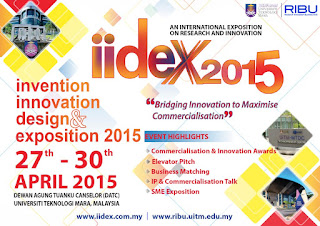We went to iidex 2015 today (28th April 2015) held at DATC, UiTM as instructed by our MIS750 lecturer Assoc. Prof. Dr. Norzaidi Haji Mohd Daud. There were various IT related products that were exhibited apart from other types of inventions.
An application that really attracts my attention was Arabic-Malay Cognates As A Computer Assisted Language Learning developed by Roaya Shehab. Although if I am not mistaken the system did not win any prize in iidex 2015.
http://ieeexplore.ieee.org/xpl/articleDetails.jsp?arnumber=7076891&punumber%3D7076841%26filter%3DAND(p_IS_Number%3A7076851)%26pageNumber%3D2
According to the developer, there is about 3,000 Malay words which are similar in pronunciation and meaning (cognates) with Arabic words. This is not surprising as every language actually loans words from other languages. As in Malay language case, among others, it loans words from Sanskrit, Arab, Portuguese, and English languages. Therefore using this application, learning Arabic language by a person proficient in Malay can be made easier as there is about 3,000 words readily recognizable.
A user can key in or copy a whole Arabic sentence and the application can recognize the cognates. The application also calculates similarities (in percentages) of the Malay-Arabic cognates. For example, the word ‘bank’ has 100% similarities while the word ‘zirafah’ has 57% similarities.
Although the Malay-Arabic cognates is not new, but using an application to recognize the cognates in a sentence is important as Malay speakers sometimes come across these words when reading the Quran and need to understand them. Usually, a proficient Malay speaker can only recognize words originated from English as English is a second language in Malaysia. Words originated from Sanskrit and Portuguese are the hardest to recognize as these languages are not the lingua francas anymore and I believe that almost all Malay speakers do not really care the origin of those words as almost all of them are not linguists.
However, I found out that many other words should be included. For example, the singular word ‘haiwan’ is included, but the plural ‘hayawan’ is not. Although there is a feature that a user can use to key in words, but I think only the system administrator should be allowed to include cognates. The feature for the user should be changed to suggest word(s) to the administrator.




